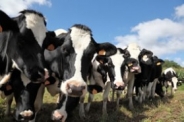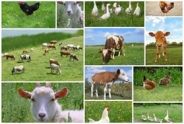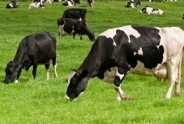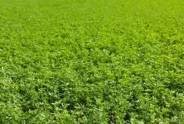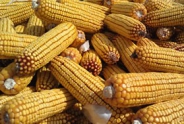An Innovative Approach to Cow Cooling
Jackson Wright, Dairy
Northwest New York Dairy, Livestock & Field Crops
May 1, 2012
Currently, the primary methodologies for heat abatement on dairy operations are the combination of shade, fans, and sprinklers. Sprinklers provide the most effective method for cow cooling as they facilitate evaporative cooling, however many have raised concerns over excessive water usage on agricultural operations. One way to address these concerns while still providing adequate heat abatement measures would be to look to the south. In Texas droughts are common and as a result rainwater collection systems are widely used to maximize the use of this precious resource. Utilizing rainwater as the primary water source for cow cooling systems would offer many benefits as collecting rainwater would reduce demand on utilities during peak summer usage. After the initial installation, water collected would be free to the dairy producer reducing utility bills; utilizing rainwater would reduce pressure on many manure management systems; and because rainwater provides water with zero hardness, this approach would eliminate scale build up on sprinkler heads.
In addition, dairy operations inherently have a large roof surface area in order to provide adequate housing to their cows. Moreover, the northeast has relatively consistent rainfall throughout the summer months with western New York averaging 3.34 inches of rain in June, 3.47 inches of rain in July, and 3.38 inches of rain in August. According to the Texas Manual on Rainwater Harvesting, approximately 0.62 gallons per square foot per inch of rainfall can be collected through rainwater collection systems. Conservatively, a dairy operation with 25,000 square feet of roof surface area with 3.3 inches of rainfall would capture 51,150 gallons of rainwater per month. For feed line sprinkler applications, assuming 500 feet of bunk space with sprinkler heads placed every 8 feet using a 0.5 gallon of water per minute, running 12 hours each day and cycling ON for 1 minute at 15 minutes intervals. The cow cooling system would require 1,512 gallons of water per day, or 45,360 gallons per month. Similarly, the holding area would be of interest as this area is the most hostile environment on the farm in relation to heat stress. For holding area sprinkler applications, assuming the holding area that is 20' by 100' with a sprinkler system delivering 1 gallon per 150 square feet per minute, running 12 hours each day and cycling ON for 1 minute at 6 minute intervals would require 1442 gallons of water per day, or 43,260 gallons per month. Both applications are below the anticipated amount of collected rainwater, suggesting that utilizing rainwater as the primary water source for cow cooling systems is feasible in the Northeast during the summer months.
Finally, because the water being harvested is used for cow cooling, water quality is not a primary concern. Therefore for this application a rainwater collection system can be installed relatively cheaply. To harvest rainwater for cow cooling would require reliable gutters that minimize overflow and water loss. A first flush diverter, to minimize contamination from the roof surface such as dust, leaves, blooms, twigs, insect bodies, animal feces, pesticides and other airborne residues, and a roof washers connecting the gutters to the storage tank to filter leaves and other small debris and minimize mosquito breeding. A polypropylene storage tank will also be needed, and that must be green or black to prevent algae growth, and finally, a water pump. These systems would be most beneficial to producers on municipal water supply or who struggle with hard water or low water supply during the summer months.
Upcoming Events
2026 Corn Congress
January 14, 2026
Henrietta, NY
Participant Registration for the 2026 Corn Congress NOW OPEN!
NOW OFFERING 1.5 DEC Recertification CREDITS
2026 Forage Congress
January 28, 2026
Nunda, NY
Register to attend 2026 Forage Congress!
2026 Soybean & Small Grains Congress
February 11, 2026
Henrietta, NY
Announcements
The NWNY Team is Hiring!
The NWNY Dairy, Livestock and Field Crops Team is currently looking for an Area Dairy Management Specialist as well as a Small Farms and Livestock Specialist:The full position descriptions and instructions on how to apply are available here:
Area Dairy Management Specialist: https://academicjobsonline.org/ajo/jobs/31178
Small Farms and Livestock Specialist: https://academicjobsonline.org/ajo/jobs/30979
Follow us on Instagram
See photos and reels of our most recent events and programs!Join us on Facebook!
Follow us on Facebook to get up to date posts about events, workshops and everything NWNY!Add us on LinkedIn!
Connect with us on LinkedIn to get more information about upcoming workshops and programs!

